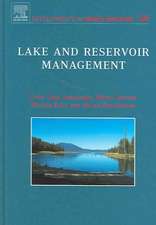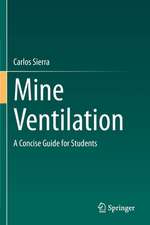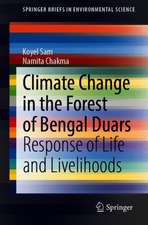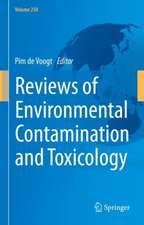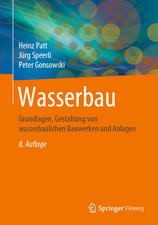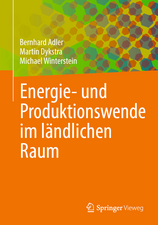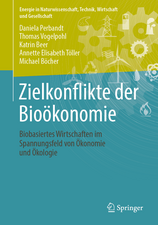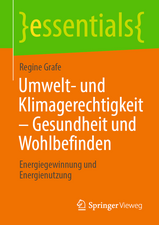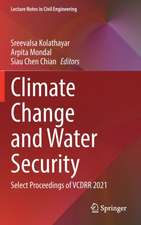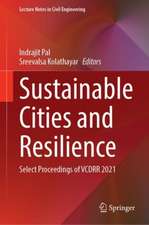Understanding and Solving Environmental Problems in the 21st Century: Toward a New, Integrated Hard Problem Science
Editat de R. Costanza, S.E. Jorgensenen Limba Engleză Hardback – 4 iun 2002
• integrated modeling and assessment
• complex, adaptive, hierarchical systems
• ecosystem services
• science and decision-making
• ecosystem health and human health
• quality of life and the distribution of wealth and resources.
This book will act as a state of the art assessment of integrated environmental science and its relation to real world problem solving. It is aimed not only at the academic community, but also as a sourcebook for managers, policy makers, and the informed public. It deals both with the state of the science and the level of consensus among scientists on key environmental issues.
The concepts underlying this book were developed at the 2nd EcoSummit workshop held in Halifax, Nova Scotia, June, 2000, with active participation from all delegates, and attempts to present their collective view.
Preț: 781.21 lei
Preț vechi: 1070.15 lei
-27% Nou
Puncte Express: 1172
Preț estimativ în valută:
149.55€ • 153.81$ • 124.07£
149.55€ • 153.81$ • 124.07£
Carte tipărită la comandă
Livrare economică 19 februarie-05 martie
Preluare comenzi: 021 569.72.76
Specificații
ISBN-13: 9780080441115
ISBN-10: 0080441114
Pagini: 346
Dimensiuni: 150 x 225 x 21 mm
Greutate: 0.66 kg
Editura: ELSEVIER SCIENCE
ISBN-10: 0080441114
Pagini: 346
Dimensiuni: 150 x 225 x 21 mm
Greutate: 0.66 kg
Editura: ELSEVIER SCIENCE
Cuprins
Preface. EcoSummit Participant List. Introduction: Understanding and Solving Environmental Problems
in the 21st Century: Toward a new, integrated "hard problem science" (R. Costanza, S.E. Jørgensen). References. 1. Integrated Assessment and Modeling - Science for Sustainability (G. Harris). Abstract. Introduction. The global context. Changes to the enterprise of scientific research. "Clean and green" drivers on policy and markets. The science of IA and IAM - integration and synthesis. IAM and ESM - the science of the future? References. 2. The Potential for Integrated Assessment and Modeling to Solve Environmental Problems: Vision, Capacity, and Direction (P. Parker et al.). Introduction. Integration. Visions of the future. Optimistic view. Pessimistic view. Evolution of IAM. IAM current position: Points of agreement. Case studies. Model complexity. Validation. Integrated Assessment. Agent-based models. Communication. Values in models. Future of IAM. Links to other groups. Conclusion. References. 3. Complex Adaptive Hierarchical Systems (B.C. Patten et al.). The new confrontation - biocomplex wholeness. Complexity. Adaptation and hierarchy. Measuring the organizational complexity of CAHSystems. Measuring the complexity of genomes and organisms - biocomplexity. Exergy-based orientors in a natural (virgin) forest. Exergy and information of solar radiation. Emergy and exergy. Integration of orientors. Adaptation and hierarchy, again. Systemicity. Eco-anthropic CAHSystems. A polycentric approach to integrated assessment. Eco-geological assessment towards sustainable coastal development in
Yogyakarta, Indonesia - scale adjustment to observe and analyze CAHSystems. Contents. Concluding thoughts. Glossary. References.
4. Complex Adaptive Hierarchical Systems (B.C. Patten et al.). Introduction. About theory. About applications. About modeling. Conclusions. References. 5. Ecosystem Services, Their Use and the Role of Ecological Engineering:
State of the Art (A. Dakers). Introduction. Defining ecosystem services. Humankind's relationship with the natural environment. Anthropocentric or ecocentric valuing. Ecosystem relationships - embeddedness. Valuing ecosystem services. The use and misuse of ecosystem services. Designing and engineering to restore a sustainable relationship with ecosystems. Making better use of ecosystem services. Frontline projects. Players involved in achieving better use of ecosystem services. Engineer as designer. Ecological engineering. Case Study 1: Ministry of Transport in the Netherlands. Case Study 2: Oxelösund Våtmark, Sweden. Case Study 3: Donaumoos - Germany. Case Study 4: Kaja, Ås, Norway. Case Study 5: Aremark. Case Study 6: Kågeröd Recycling Project. Case Study 7: Ruswil, Switzerland. Case Study 8: Calcutta Wastewater-fed Aquaculture. Case Study 9: Stensund Aquaculture Centre. Case Study 10: Water Enhancement Programme, Christchurch. Case study evaluation. Under-utilization of ecosystem services. Conclusions. Acknowledgements. References. 6. Ecosystem Services (B. Guterstam et al.). Introduction. Ecosystem services. Key questions and common ground. The role of ecosystems services tomorrow. Conclusions. References. 7. Science and Decision-Making (V.H. Dale). Science and decision-making. Scientists' role in decision-making. Three case studies. Mount St. Helens. Tennessee Cedar Barrens. The Brazilian Amazon. Lessons learned. Characteristics of scientists and decision-makers influence how they interact. Questions about the relationship between science and decision-making. Acknowledgements. References. 8. Science and Decision-Making (E.J. Rykiel Jr. et al.). Introduction. Working definitions. Multiple roles of science. The role of scientists in controversial issues. Scientists and activism. Education of scientists. Science based on holism. Increasing the effectiveness of the individual environmental scientist. Pathways to involvement in decision-making. Changing the environmental science curriculum. Case studies. Integrating science and economics for environmental policymaking in Europe. Lake management and demand-driven research in the Netherlands. Conclusions. Acknowledgements. References. 9. Ecosystem Health and Human Health (L. Vasseur et al.). Introduction. Ecosystems, humans, and the concept of health. Ecosystems. Health. Ignoring the link. Climate change. Agrosystems and food production. Biodiversity and declining productive capacity. Discussion. Acknowledgements. References. 10. Ecosystem Health and Human Health: Healthy Planet, Healthy Living (L. Vasseur et al.). Abstract. Introduction. Linkages between ecosystem health and human health. Air quality. Water resources. Food resources. Soils. Biodiversity. Other models. Sources of solutions. Priority actions. Barriers to effective action. Sustenance needs. Little connection to the land. Resistance to change. Ignorance. Low critical mass. Measures, indicators, or metrics of progress. Conclusions. Acknowledgements. References. 11. Quality of Life and the Distribution of Wealth and Resources (R. Costanza et al.). Abstract. How is Quality of Life (QOL) defined? How has Quality of Life been measured? Economic income, economic welfare, and human welfare. Level and pattern of economic activity: gross national product. Sustainable economic income. Measuring economic welfare. Contents. Assessing human welfare directly. A comparison of two approaches to fairness in the distribution of wealth
and resources. Fairness across individuals in space. Fairness across individuals in time. Fairness across countries in space and time. Can we measure fairness? What is the relationship between fairness and QOL? Principles for achieving a sustainable, fair, and high-QOL society. Acknowledgments. References. 12.
Quality of Life and the Distribution of Wealth and Resources
(J. Farley et al.). Abstract. How do we define Quality of Life (QOL)? What are human needs? Satisfiers and wants. Implications of our definition for improving QOL. QOL and the four capitals. How can we measure QOL? Are objective measures suitable? Operationalizing human needs assessment as a measure of QOL. Ecosystem services: indicators to integrate with QOL. The implications of using HNA as a measure of QOL. Development of indicators of fairness in the distribution of wealth and
resources. Natural capital and market failures. The elimination of poverty. Maximum income level. Geographical fairness. Approaches to measuring fairness. Ecosystem health and functioning markets. Poverties and pathologies. Wealth and power. A Quality of Life Gini Coefficient? Implications of the relationship between fairness and QOL. Positional wealth. Contents. Income inequality as a detriment to QOL. Do we still need incentives to produce? How do we achieve sustainable, fair, and high QOL? Current world setting. Policy suggestions. Natural capitalism, increased efficiency, industrial ecology, and dematerialization. Conclusion. Appendix. The Sustainability Bill of Rights. References. Conclusions (R.E. Jørgensen, R. Costanza).
References. Author Index. Subject Index.
in the 21st Century: Toward a new, integrated "hard problem science" (R. Costanza, S.E. Jørgensen). References. 1. Integrated Assessment and Modeling - Science for Sustainability (G. Harris). Abstract. Introduction. The global context. Changes to the enterprise of scientific research. "Clean and green" drivers on policy and markets. The science of IA and IAM - integration and synthesis. IAM and ESM - the science of the future? References. 2. The Potential for Integrated Assessment and Modeling to Solve Environmental Problems: Vision, Capacity, and Direction (P. Parker et al.). Introduction. Integration. Visions of the future. Optimistic view. Pessimistic view. Evolution of IAM. IAM current position: Points of agreement. Case studies. Model complexity. Validation. Integrated Assessment. Agent-based models. Communication. Values in models. Future of IAM. Links to other groups. Conclusion. References. 3. Complex Adaptive Hierarchical Systems (B.C. Patten et al.). The new confrontation - biocomplex wholeness. Complexity. Adaptation and hierarchy. Measuring the organizational complexity of CAHSystems. Measuring the complexity of genomes and organisms - biocomplexity. Exergy-based orientors in a natural (virgin) forest. Exergy and information of solar radiation. Emergy and exergy. Integration of orientors. Adaptation and hierarchy, again. Systemicity. Eco-anthropic CAHSystems. A polycentric approach to integrated assessment. Eco-geological assessment towards sustainable coastal development in
Yogyakarta, Indonesia - scale adjustment to observe and analyze CAHSystems. Contents. Concluding thoughts. Glossary. References.
4. Complex Adaptive Hierarchical Systems (B.C. Patten et al.). Introduction. About theory. About applications. About modeling. Conclusions. References. 5. Ecosystem Services, Their Use and the Role of Ecological Engineering:
State of the Art (A. Dakers). Introduction. Defining ecosystem services. Humankind's relationship with the natural environment. Anthropocentric or ecocentric valuing. Ecosystem relationships - embeddedness. Valuing ecosystem services. The use and misuse of ecosystem services. Designing and engineering to restore a sustainable relationship with ecosystems. Making better use of ecosystem services. Frontline projects. Players involved in achieving better use of ecosystem services. Engineer as designer. Ecological engineering. Case Study 1: Ministry of Transport in the Netherlands. Case Study 2: Oxelösund Våtmark, Sweden. Case Study 3: Donaumoos - Germany. Case Study 4: Kaja, Ås, Norway. Case Study 5: Aremark. Case Study 6: Kågeröd Recycling Project. Case Study 7: Ruswil, Switzerland. Case Study 8: Calcutta Wastewater-fed Aquaculture. Case Study 9: Stensund Aquaculture Centre. Case Study 10: Water Enhancement Programme, Christchurch. Case study evaluation. Under-utilization of ecosystem services. Conclusions. Acknowledgements. References. 6. Ecosystem Services (B. Guterstam et al.). Introduction. Ecosystem services. Key questions and common ground. The role of ecosystems services tomorrow. Conclusions. References. 7. Science and Decision-Making (V.H. Dale). Science and decision-making. Scientists' role in decision-making. Three case studies. Mount St. Helens. Tennessee Cedar Barrens. The Brazilian Amazon. Lessons learned. Characteristics of scientists and decision-makers influence how they interact. Questions about the relationship between science and decision-making. Acknowledgements. References. 8. Science and Decision-Making (E.J. Rykiel Jr. et al.). Introduction. Working definitions. Multiple roles of science. The role of scientists in controversial issues. Scientists and activism. Education of scientists. Science based on holism. Increasing the effectiveness of the individual environmental scientist. Pathways to involvement in decision-making. Changing the environmental science curriculum. Case studies. Integrating science and economics for environmental policymaking in Europe. Lake management and demand-driven research in the Netherlands. Conclusions. Acknowledgements. References. 9. Ecosystem Health and Human Health (L. Vasseur et al.). Introduction. Ecosystems, humans, and the concept of health. Ecosystems. Health. Ignoring the link. Climate change. Agrosystems and food production. Biodiversity and declining productive capacity. Discussion. Acknowledgements. References. 10. Ecosystem Health and Human Health: Healthy Planet, Healthy Living (L. Vasseur et al.). Abstract. Introduction. Linkages between ecosystem health and human health. Air quality. Water resources. Food resources. Soils. Biodiversity. Other models. Sources of solutions. Priority actions. Barriers to effective action. Sustenance needs. Little connection to the land. Resistance to change. Ignorance. Low critical mass. Measures, indicators, or metrics of progress. Conclusions. Acknowledgements. References. 11. Quality of Life and the Distribution of Wealth and Resources (R. Costanza et al.). Abstract. How is Quality of Life (QOL) defined? How has Quality of Life been measured? Economic income, economic welfare, and human welfare. Level and pattern of economic activity: gross national product. Sustainable economic income. Measuring economic welfare. Contents. Assessing human welfare directly. A comparison of two approaches to fairness in the distribution of wealth
and resources. Fairness across individuals in space. Fairness across individuals in time. Fairness across countries in space and time. Can we measure fairness? What is the relationship between fairness and QOL? Principles for achieving a sustainable, fair, and high-QOL society. Acknowledgments. References. 12.
Quality of Life and the Distribution of Wealth and Resources
(J. Farley et al.). Abstract. How do we define Quality of Life (QOL)? What are human needs? Satisfiers and wants. Implications of our definition for improving QOL. QOL and the four capitals. How can we measure QOL? Are objective measures suitable? Operationalizing human needs assessment as a measure of QOL. Ecosystem services: indicators to integrate with QOL. The implications of using HNA as a measure of QOL. Development of indicators of fairness in the distribution of wealth and
resources. Natural capital and market failures. The elimination of poverty. Maximum income level. Geographical fairness. Approaches to measuring fairness. Ecosystem health and functioning markets. Poverties and pathologies. Wealth and power. A Quality of Life Gini Coefficient? Implications of the relationship between fairness and QOL. Positional wealth. Contents. Income inequality as a detriment to QOL. Do we still need incentives to produce? How do we achieve sustainable, fair, and high QOL? Current world setting. Policy suggestions. Natural capitalism, increased efficiency, industrial ecology, and dematerialization. Conclusion. Appendix. The Sustainability Bill of Rights. References. Conclusions (R.E. Jørgensen, R. Costanza).
References. Author Index. Subject Index.
Recenzii
"...for the reader...who wants to investigate the range of approaches used in the study of contemporary environmental problems, it does provide a useful introduction." --Timothy A. Quine, in THE HOLOCENE, VOL. 15, 2005



